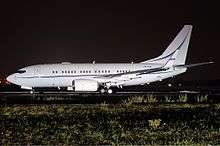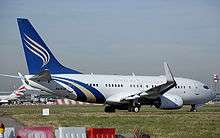Boeing Business Jet
| Boeing Business Jet | |
|---|---|
 | |
| Artist's impression of the entire BBJ family | |
| Role | Business jet |
| Manufacturer | Boeing Commercial Airplanes |
| First flight | September 4, 1998 |
| Introduction | 1999 |
| Produced | 1998–present |
| Number built | 217 – As of 31 October 2016 (including BBJ1, BBJ2, BBJ3, 747BBJ, 757BBJ, 767BBJ, 777BBJ & 787BBJ)[1] |
| Unit cost |
US$232–945.6 billion as of 2016 |
The Boeing Business Jet series are variants of Boeing jet airliners for the corporate jet market. The Boeing Business Jet is a 50/50 partnership between Boeing Commercial Airplanes and GE Aviation.
The BBJ designation denotes the business jets based upon the 737 series airliners. These aircraft usually seat between 25 and 50 passengers within a luxurious configuration. This may include a master bedroom, a washroom with showers, a conference/dining area, and a living area. Boeing Business Jets also has corporate jet configurations based on the Boeing 777, Boeing 787 and the Boeing 747-8 Intercontinental, which are known as 777 VIP, 787 VIP, and 747-8 VIP, respectively.
Boeing BBJ (737-based)
The Boeing BBJ is primarily a 737 commercial airframe with modifications to provide for private jet service. The BBJ1 is based on a 737-700 airframe, with elements from the 737–800. The BBJ2 and BBJ3 are based on the 737–800 and 737-900ER series, respectively.
All 11[2] models include changes to the airframe regardless of the BBJ series. Fokker Services are developing 1.5 meter wide windows for the BBJ in 2016.[3][4]
Changes from the normal 737 include:
- Blended winglets for additional fuel economy (3–5% improvement) as standard (winglets are optional on airliner 737s)
- Self-contained airstairs for disembarking at airports with limited ground support
- Additional fuel tanks, for intercontinental range
- ETOPS-180 certification
After the launch of the BBJ, Airbus followed suit with the launch of the Airbus ACJ derived from its A319 commercial airframe. It has also launched the larger A320 and the smaller A318 Elite. Other competitors at the smaller end of the market include the Embraer Lineage, the Bombardier Global Express, the Gulfstream G550 and the Gulfstream G650. A BBJ may cost around US$10/mile to operate, whereas the G650 and similar may cost $5–6.[5]
Models
Narrow-body models
- BBJ, or less frequently BBJ1, is based on the 737-700, and formed the basis for the 737-700ER. This was the initial variant. In United States Air Force service, this is known as the C-40B Clipper.
- BBJ2 is based on the 737–800.
- BBJ3 is based on the 737-900ER.
- BBJ C is a variant of the BBJ featuring the "quick change" capabilities of the 737-700C. This allows the aircraft to be used for executive duty during one flight, and to be quickly reconfigured for cargo duty for the next flight.
- BBJ MAX 8 and BBJ MAX 9 are proposed variants of the Boeing 737 MAX 8 and 9 with new CFM LEAP-1B engines and advanced winglets providing 13% better fuel burn; the BBJ MAX 8 will have a 6,325 nautical miles (7,279 mi; 11,714 km) range and the BBJ MAX 9 a 6,255 nautical miles (7,198 mi; 11,584 km) range.[6] The BBJ MAX 7 was unveiled in October 2016 and will have a 7,000 nautical miles (8,100 mi; 13,000 km) range, with 10% lower operating costs than the original BBJ while having a longer cabin and more under-floor baggage space.[7]
Wide-body models
_at_LHR.jpg)
- 747 VIP: version of the 747-8 ordered by the Boeing Business Jet division. There are currently seven orders for this aircraft. The VIP 747 is delivered by BBJ in a "green" condition, meaning there are no interior furnishings so that the owner can design it to personal preference. This plane has a range of 9,260 nmi (17,150 km).
- 777 VIP: version of the 777 ordered by the Boeing Business Jet division. It is a modified version of the 777-200LR, and Boeing 777X with a range of 10,100 nmi (18,700 km).
- 787 VIP: version of the 787-8/-9 ordered by the Boeing Business Jet division. There are 15 orders for this aircraft. As with the 747, the VIP 787 is delivered by BBJ in a "green" condition. The −8 has a range of 9,590 nmi (17,760 km) and the −9 has a range of 9,950 nmi (18,430 km).
Orders and deliveries
| Breakdown by aircraft | 737 | BBJ | MAX | 757 | 767 | 777 | 787 | 747-400 | 747-8 | Total |
|---|---|---|---|---|---|---|---|---|---|---|
| Orders | 15 | 164 | 12 | 5 | 8 | 9 | 15 | 3 | 8 | 239 |
| Deliveries | 14 | 162 | 0 | 5 | 8 | 8 | 9 | 3 | 8 | 217 |
| In Service | 13 | 154 | 0 | 5 | 8 | 5 | 3 | 3 | 6 | 197 |
Data through October 31, 2016[1]
Operators

_(Boeing_Business_Jet_3)_9K-GCC.jpg)
State VIP users
 Niger
Niger- Niger Air Force (1) for government VIP flight
-
 Australia
Australia - Royal Australian Air Force (2) leased BBJ737
-
 Belarus
Belarus - Belarus Air Force (1) BBJ2 for Government VIP flight[8]
-
 Colombia
Colombia - Colombian Air Force (1)
-
 India
India - Indian Air Force (3)
-
 Indonesia
Indonesia - Presidency (1) BBJ2 for Government VVIP flight.
-
 Kazakhstan
Kazakhstan - Government of Kazakhstan (1)
-
 Kuwait
Kuwait - Government of Kuwait (2)
-
 Madagascar
Madagascar - Presidency (1)
-
 Malaysia
Malaysia - Royal Malaysian Air Force (1)
-
 Morocco
Morocco - Royal Moroccan Air Force (2)
-
 Nigeria
Nigeria - Nigerian Air Force (1)
-
 Qatar
Qatar - Qatar Amiri Flight (2)
-
 South Africa
South Africa - South African Air Force (1)
-
 Tunisia
Tunisia - Republic of Tunisia Government (1)
-
 United Arab Emirates
United Arab Emirates - Royal Jet (6) BBJ2 for Government VIP flight[8]
Specifications
The specifications for the various members of the BBJ family are as follows:[9][10][11][12][13][14][15][16][17][18]
| Measurement | BBJ1 | BBJ MAX 8 | 747 VIP | 777 VIP | 787 VIP |
|---|---|---|---|---|---|
| Cockpit Crew | 4-6 | 3 | |||
| Length | 33.63 m (110 ft 4 in) | 39.5 m (129 ft 8 in) | 76.4 m (250 ft 8 in) | 63.73 m (209 ft 1 in) | 62.81 m (206 ft 1 in) |
| Wingspan | 35.79 m (117 ft 5 in) | 35.92 m (117 ft 10 in) | 68.5 m (224 ft 7 in) | 64.8 m (212 ft 7 in) | 60.12 m (197 ft 3 in) |
| Wing area | 1,341 sq ft | 1,373 sq ft | 5,960 sq ft | 5,520 sq ft | 3,880 sq ft |
| Height | 12.57 m (41 ft 3 in) | 12.3 m (40 ft 4 in) | 19.6 m (64 ft 4 in) | 18.6 m (61 ft 1 in) | 17.02 m (55 ft 10 in) |
| Empty weight | 94,570 lb (42,895 kg) - 98,500 lb (44,700 kg) | 141,700 lb (64,300 kg) | 472,900 lb (214,500 kg) | 320,000 lb (150,000 kg) | 284,000 lb (129,000 kg) |
| Maximum fuel capacity | 10,707 US gallons (40,530 L) | 10,420 US gallons (39,444 L) | 63,286 US gallons (239,564 L) | 47,890 US gallons (181,283 L) | 33,384 US gallons (126,372 L) |
| Maximum take-off weight | 171,000 pounds (77,564 kg) | 181,200 pounds (82,191 kg) | 1,003,103.29 pounds (455,000 kg) | 766,000 pounds (347,452 kg) | 557,000 pounds (252,651 kg) |
| Maximum landing weight | 134,000 pounds (60,781 kg) | 152,800 pounds (69,309 kg) | 910,000 pounds (412,769 kg) | 492,000 pounds (223,167 kg) | 425,000 pounds (192,777 kg) |
| Maximum zero-fuel weight | 111,000 pounds (50,349 kg) | 145,000 pounds (65,771 kg) | 833,000 pounds (377,842 kg) | 414,500 pounds (188,014 kg) | 400,000 pounds (181,437 kg) |
| Cruising speed | Mach 0.78 | Mach 0.79 | Mach 0.85 | Mach 0.84 | Mach 0.85 |
| Maximum speed | 890 km/h (481 kn, Mach 0.82) | Mach 0.84 | Mach 0.90 | Mach 0.92 | Mach 0.95 (323 m/s) |
| Required runway at MTOW | 5,249 ft (1,600 m) | (unknown) | 10,200 ft (3,100 m) | 9,200 ft (2,800 m) | 9,400 ft (2,900 m) |
| Range | 6200 nmi (11,480 km) 8 passengers | 6,555 nmi (12,140 km) 8 passengers | 9,260 nmi (17,150 km) | 10,100 nmi (18,700 km) | 9,950 nmi (18,430 km) |
| Service Ceiling | 41,000 ft (12,000 m) | (unknown) | 50,000 ft (15,000 m) | 43,100 ft (13,100 m) | 45,100 ft (13,700 m) |
| Wing sweep | 25.02° | 27.5° | 37.5° | 33.5° | 32.2° |
| Powerplants | Two CFM International CFM56-7 | Two CFM International LEAP-1B | Four General Electric GEnx | Two General Electric GE90-115B1 | Two Rolls-Royce Trent 1000 |
| Maximum thrust | 11,740 kg (26,400 lbf) each | 12,500 kg (28,000 lbf) each | 32,680 kg (72,300 lbf) each | 52,300 kg (115,300 lbf) each | 32,570 kg (72,066 lbf) each |
See also
- Related development
- Boeing 737
- Boeing 737 MAX
- Boeing C-40 Clipper
- Boeing 747-8
- Boeing 777
- Boeing 777X
- Boeing 787 Dreamliner
- Aircraft of comparable role, configuration and era
- Airbus A318 Elite
- Airbus ACJ
- Airbus Corporate Jets
- Bombardier Global Express
- Embraer Lineage 1000
- Gulfstream G550
- Gulfstream G650
- Gulfstream V
- Related lists
- Air transports of heads of state and government
- List of active United States military aircraft
- List of civil aircraft
- List of military aircraft of the United States
References
- 1 2 http://www.boeing.com/commercial/bbj/#/orders-and-deliveries
- ↑ Lynch, Kerry (16 May 2015). "Boeing Business Jets confident as it studies Combi". Aviation International News. Retrieved 18 May 2015.
- ↑ http://www.ainonline.com/aviation-news/business-aviation/2015-05-20/first-skyview-bbj
- ↑ Fokker proposes giant window to Boeing Business Jets" Archive
- ↑ Table Mission Costs for Ultra-Long-Range Jets
- ↑ "Boeing Business Jets to Offer the BBJ MAX" (Press release). Boeing. October 29, 2012. Retrieved October 30, 2012.
- ↑ "Boeing Business Jets Unveils BBJ MAX 7" (Press release). Boeing. October 31, 2016. Retrieved November 1, 2016.
- 1 2 http://www.aerospace-technology.com/projects/bbj/[]
- ↑ Boeing 747-8 Technical Specifications. Boeing. Retrieved November 11, 2007.
- ↑ 747-8 Airport Compatibility Report. Boeing, December 2011.
- ↑ 747-8 Airport Compatibility brochure Archived 2009-08-05 at WebCite. Boeing, January 2008.
- ↑ "787 Airplane Characteristics for Airport Planning" (PDF). Boeing Commercial Aircraft. November 2014.
- ↑ http://www.boeing.com/assets/pdf/commercial/airports/acaps/737sec2.pdf
- ↑ Boeing 737 Technical Information, Boeing Commercial Airplanes.
- ↑ Boeing 737 Airplane Characteristics for Airport Planning, Boeing Commercial Airplanes.
- ↑ "BBJ 777-200LR: Specifications". Boeing. Retrieved 9 July 2016.
- ↑ "BBJ-777-LR". Boeing. Retrieved 9 July 2016.
- ↑ Boeing 737 MAX 8 specifications retrieved 16 July 2016
External links
| Wikimedia Commons has media related to Boeing Business Jet. |
